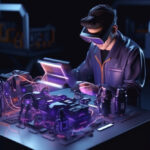Revolutionizing Construction: Augmented Reality’s Role in Building the Future

Augmented reality (AR) — an emerging technology that overlays digital information onto physical reality — could revolutionize construction industry processes. AR provides numerous potential uses and advantages that may alter the construction landscape dramatically.
From project visualization and enhanced safety briefings to improved accuracy in construction tasks, AR promises to redefine the future of construction. This article delves into the exciting possibilities that AR presents in revolutionizing the construction field.
After reading this article, check out XYZ Reality for further information on the Atom headset; a revolutionary piece of technology that harnesses AR for construction.
Augmented Reality in Project Visualization
AR is dramatically transforming project visualization in the construction industry in several impactful ways:
3D visualization
AR allows architects and engineers to create 3D models of proposed buildings. These models can be overlaid on the actual construction site, enabling stakeholders to visualize the finished project in its intended environment long before construction begins.
Interactive design modifications
With AR, changes to the design can be made in real-time during client meetings. This allows for immediate feedback and approval, reducing lengthy back-and-forth communication and accelerating the design process.
Accurate spatial understanding
AR provides a real sense of scale and space that 2D drawings can’t match. This technology aids in understanding how new constructions will fit into existing spaces or how big the rooms inside a new building will feel.
Client engagement
AR technology can provide immersive walkthroughs of yet-to-be-built structures, greatly enhancing client involvement and excitement about the project. This type of interactive and engaging presentation can result in quicker decision-making and increased client satisfaction.
By transforming blueprints into interactive 3D models and offering real-time design changes, AR is revolutionizing project visualization in construction.
Enhancing Safety Briefings with AR
AR plays a vital role in enhancing safety in construction in numerous ways:
- Hazard simulation: AR can simulate potential safety risks in a controlled environment, allowing workers to understand and respond to dangerous scenarios without real-world risk. This practical training can significantly reduce accidents on construction sites.
- Safety briefings: AR can bring safety briefings to life by overlaying digital safety indicators and warnings onto the construction site. This real-world context makes safety instructions more intuitive, memorable, and effective.
- Equipment operation: AR can guide equipment operators in real-time, displaying the safest and most efficient paths or showing the operator what’s behind a wall before drilling. This can prevent mishaps and injuries.
- Maintenance and inspection: AR can highlight areas that require routine safety checks or maintenance, ensuring nothing is overlooked. It can also guide inspectors through safety protocols, making the inspection process more thorough and reliable.
- Emergency drill: AR can simulate emergency situations, like fires or structural collapses, providing workers invaluable practice in dealing with such events. This can result in faster, more organized responses in real emergencies.
Improving Construction Accuracy with Augmented Reality
AR dramatically improves the accuracy of construction tasks, reducing the likelihood of errors and rework. Here’s how.
Exact measurements
AR can display precise measurements directly in real-world environments. Workers can see the exact dimensions of structures or spaces, ensuring that all elements are built to the precise size and specifications.
Positioning guides
AR can provide real-time positioning guides, showing workers where to place or install elements. This precision ensures that each component is placed correctly the first time, eliminating costly and time-consuming rework.
Alignment checks
With AR, workers can overlay digital models onto the physical world to check alignment and fit. Any misalignments or inconsistencies can be spotted and corrected immediately, preventing future issues.
Quality control
AR can highlight deviations from the design in real-time as the construction progresses. This allows immediate quality control checks and swift remedial action, ensuring that the final structure adheres to the original design.
Task sequencing
AR can indicate the optimal sequence of tasks, showing workers the most efficient order in which to complete their work. This can increase productivity and help prevent mistakes that occur when tasks are performed out of order.
Through these capabilities, AR can significantly improve the accuracy of construction tasks, save time, reduce costs, and increase overall project efficiency.
Conclusion – Augmented Reality’s Role in Building the Future
Augmented reality is radically transforming the construction industry, improving project visualization, safety, and accuracy. Its ability to overlay digital information on the physical world creates opportunities for increased efficiency, engagement, and safety protocols.
While we are only beginning to scratch the surface of its potential — the future of construction with AR promises to be more streamlined, safer, and much more efficient.

The To Tech Award 2024: The City That Produces the Revolutionaries of Tech

The Financial Side of Moving: Budgeting and Saving Tips

Making Memories: International Rakhi Celebrations and Traditions

Pre-Requisites Before Applying for an Instant Personal Loan

Embrace the Magic of Turkey: An Unforgettable Visit

The To Tech Award 2024: The City That Produces the Revolutionaries of Tech

The Financial Side of Moving: Budgeting and Saving Tips

Making Memories: International Rakhi Celebrations and Traditions








